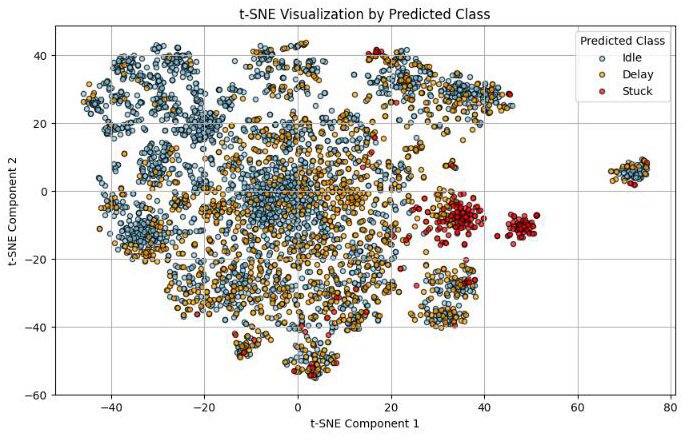Embedded machine learning for fault detection in conveyor systems using multi-sensor data and discrete wavelet transform
Author affiliations
DOI:
https://doi.org/10.15625/0866-7136/22277Keywords:
discrete wavelet transform, sensor fusion, embedded machine learning, fault detection, edge computingAbstract
This study presents a fault detection model utilizing the Seeed Studio XIAO nRF52840 Sense microcontroller development board to identify and diagnose faults in the conveyor belt system of the MPS-PA Bottling Learning System, a component of the Festo Didactic System. The microcontroller is equipped with a 6-axis Inertial Measurement Unit (IMU) and a Pulse Density Modulation (PDM) microphone, enabling it to monitor vibrations and sounds generated during conveyor belt operation. The collected signals are processed using the Discrete Wavelet Transform (DWT) to extract relevant features, which are then used to train an embedded machine learning model designed to detect faults such as bottle obstructions and falls. The conveyor belt transports empty bottles to a dispenser, but a 90-degree turn in the path frequently causes disruptions, resulting in bottle rotation or falls. The IMU captures vibration data, while the PDM microphone records audio signals during these events. The processed DWT features are utilized to train the fault detection model. The model is developed using the TensorFlow Lite framework, incorporating batch normalization to stabilize and accelerate the learning process. Once deployed, the system predicts faults and sends Bluetooth alerts to a host PC when an issue is detected, allowing the process to be halted to prevent further damage. The proposed fault detection model demonstrates promising results, achieving up to 94% accuracy. Additionally, the system's low power consumption, supported by a 200 mAh LiPo rechargeable battery, enhances energy efficiency, contributing to more sustainable manufacturing operations.
Downloads
References
[1] I. Elbadawi, M. A. Ashmawy, W. A. Yusmawiza, I. A. Chaudhry, N. B. Ali, and A. Ahmad. Application of failure mode effect and criticality analysis (FMECA) to a computer integrated manufacturing (CIM) conveyor belt. Engineering, Technology & Applied Science Research, 8, (2018), pp. 3023–3027. https://doi.org/10.48084/etasr.2043.
[2] G. Fedorko, V. Molnar, D. Marasova, A. Grincova, M. Dovica, J. Zivcak, T. Toth, and N. Husakova. Failure analysis of belt conveyor damage caused by the falling material. Part I: experimental measurements and regression models. Engineering Failure Analysis, 36, (2014), pp. 30–38. https://doi.org/10.1016/j.engfailanal.2013.09.017.
[3] C. Yan and X. He. Model and dynamic simulation of belt conveyor. In 2010 International Conference on Intelligent System Design and Engineering Application, IEEE, (2010), pp. 949–951. https://doi.org/10.1109/isdea.2010.331.
[4] E. Ruschel, E. A. P. Santos, and E. d. F. R. Loures. Establishment of maintenance inspection intervals: An application of process mining techniques in manufacturing. Journal of Intelligent Manufacturing, 31, (2018), pp. 53–72. https://doi.org/10.1007/s10845-018-1434-7.
[5] L. Xiao, S. Song, X. Chen, and D. W. Coit. Joint optimization of production scheduling and machine group preventive maintenance. Reliability Engineering & System Safety, 146, (2016), pp. 68–78. https://doi.org/10.1016/j.ress.2015.10.013.
[6] L. Feng and M. Rovai. XIAO: Big power, small board. Seeed Studio, (2024). https://files.seeedstudio.com/wiki/XIAO Big Power-Board-ebook-photo/XIAO Big Power Small Board v20240307.pdf.
[7] Festo. MPS-PA stations—bottling learning system, (2019).
[8] P. V. S. Anusha. Edge machine learning-enabled predictive fault detection system for conveyor belt maintenance optimization in industrial settings. Journal of Electrical Systems, 20, (2024), pp. 2031–2041. https://doi.org/10.52783/jes.4003.
[9] J. Pacheco, V. H. Benitez, G. Pérez, and A. Brau. Wavelet-based computational intelligence for real-time anomaly detection and fault isolation in embedded systems. Machines, 12, (2024). https://doi.org/10.20944/preprints202408.1710.v1.
[10] M. Heydarzadeh, S. H. Kia, M. Nourani, H. Henao, and G.-A. Capolino. Gear fault diagnosis using discrete wavelet transform and deep neural networks. In IECON 2016 - 42nd Annual Conference of the IEEE Industrial Electronics Society, IEEE, (2016), pp. 1494–1500. https://doi.org/10.1109/iecon.2016.7793549.
[11] P. Bortnowski, R. Król, and M. Ozdoba. Modelling of transverse vibration of conveyor belt in aspect of the trough angle. Scientific Reports, 13, (2023). https://doi.org/10.1038/s41598-023-46534-w.
[12] R. L. Dunn. Understanding industrial noise. Plant Engineering Magazine, (2001). https://www.plantengineering.com/articles/understanding-industrial-noise/.
[13] R. K. Jha, P. D. Swami, and D. Singh. Comparison and selection of wavelets for vibration signals denoising and fault detection of rotating machines using neighborhood correlation of SWT coefficients. In 2018 International Conference on Advanced Computation and Telecommunication (ICACAT), IEEE, (2018), pp. 1–5. https://doi.org/10.1109/icacat.2018.8933643.
[14] S. Ioffe and C. Szegedy. Batch normalization: Accelerating deep network training by reducing internal covariate shift. arXiv preprint arXiv:1502.03167, (2015). https://doi.org/10.48550/arXiv.1502.03167.
[15] N. Liao and X. Li. Traffic anomaly detection model using K-means and active learning method. International Journal of Fuzzy Systems, 24, (2022), pp. 2264–2282. https://doi.org/10.1007/s40815-022-01269-0.
[16] P. Vrignat, B. Robles, M. Avila, and F. Kratz. OPC UA: Examples of digital reporting applications for current industrial processes. DEStech Transactions on Engineering and Technology Research, (2018). https://doi.org/10.12783/dtetr/ecar2018/26363.

Downloads
Published
How to Cite
Issue
Section
Categories
License

This work is licensed under a Creative Commons Attribution-ShareAlike 4.0 International License.









